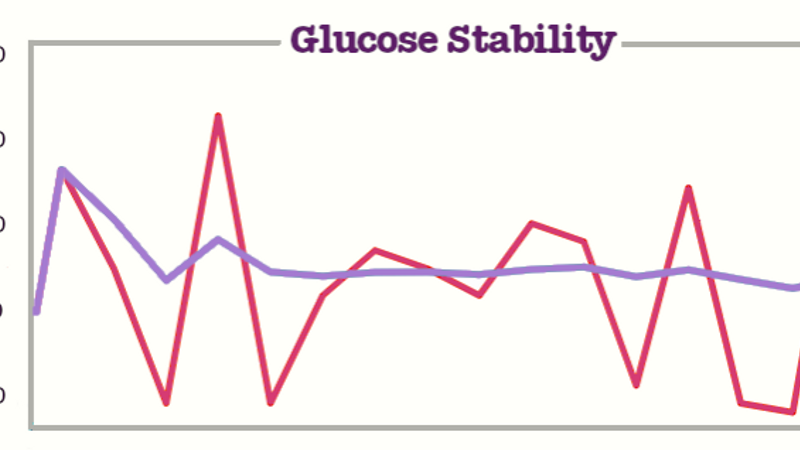

Our Review Process
Our articles undergo extensive medical review by board-certified practitioners to confirm that all factual inferences with respect to medical conditions, symptoms, treatments, and protocols are legitimate, canonical, and adhere to current guidelines and the latest discoveries. Read more.
Our Editorial Team
Shifa Fatima, MSc.
Author
Dr. Apoorva T, MHM.
MEDICAL ADVISOR
A CGM Interpretation of Stable and Sustainable Fuel
CGM will then send this data to your smartphone or a handheld device so that you will be able to see your glucose level anytime via a graph or chart. CGM significantly helps you review your glucose changes over a period of hours or days to see specific trends. Such real-time data will further assist you in making informed choices about your food, medicine and lifestyle habits. If you have diabetes, your CGM may be connected to an insulin pump, and in case your blood sugar level gets too high, the CGM will automatically deliver insulin to your blood. Generally, the lifespan of CGM is 7-14 days, after which it needs to be removed from your body and replaced.
Table of Contents
How does a CGM work?
CGM comes with an applicator that helps you apply the CGM with it. You will find a small spring-loaded needle that will guide a thin, flexible filament underneath the CGM disc through your skin and then retreat quickly, and the end of the filament will stay in the interstitial fluid below your skin. When glucose continuously seeps from your blood vessels and capillaries into the interstitial fluid, CGM will help you measure it.
How does a CGM measure glucose?
The CGM filament has a coating of the enzyme glucose oxidase that helps convert your blood glucose to hydrogen peroxide, which reacts with platinum and breaks into hydrogen, oxygen, and electrons that generate current signals. This signal will then be transmitted via your CGM wirelessly to either a handheld reader or your smartphone, where an algorithm will convert it to a glucose reading for you. Also know about normal sugar level.
Why you should use a Continuous Glucose Monitor?
There are varieties of methods for monitoring your glucose on the market - for example, a sugar check machine that only takes a drop of your blood, or the laboratory glucose tests like fasting plasma glucose or HbA1c etc. However, these methods only give you blood sugar readings for a particular time via a single measurement.
In this scenario, a Continuous Glucose Monitor gives you a more real-time look at your blood sugar level over a period of time that helps you better understand your blood sugar pattern. You get to know how much your blood sugar is spiking or crashing after eating a particular food or what kind of reaction you are having to a specific food item over time.
If you are someone with diabetes, like Type 1 diabetes, and need to continuously monitor your blood glucose level so that it doesn't get dangerously high or low, you should definitely try using a CGM. However, if you do not have diabetes, then also a CGM can help you by providing valuable insights into your blood sugar patterns to help you make better choices for your metabolic health.
What are the Benefits of a CGM?
In comparison with a standard blood glucose meter, here's how a CGM system can help you:
- You can better manage your blood glucose level every day.
- You can avoid emergencies due to lower blood glucose levels.
- It isn't a painful procedure.
What is Glucose Variability?
When you consume a specific kind of food, how much your glucose levels vary can be denoted by Glucose Variability. This metric will let you know how a particular fuel provides you with stable and sustainable energy in a specific time frame. Generally, glucose variability will show your blood glucose level in an up and down movement on a live graph or chart.
Therefore, CGM helps identify stable and sustainable fuel options that will help you chalk out proper strategies to lower your Glucose Variability. However, you should keep in mind that the strategies working for you may not work for someone else because everyone has a different body structure and different fuel requirements.
What is the best fuel source for you?
If you want to know what kind of food or amount of fuel you need to consume, you should definitely use a continuous glucose meter to avoid any sudden dip or steep spike in your blood glucose level.
For example, when wearing a CGM, have a banana and look at how your body is reacting to it immediately. Like this, you can start discovering which food types give you the most stable and sustainable fuel for your body's energy.
Sugar.fit CGM Device
sugar.fit offers you a diabetes reversal program specially designed for sustainability and long term healing via simple and sustainable lifestyle changes. Using our Continuous Glucose Monitor (CGM) device, we provide biometric feedback on how your blood sugar responds to any food, exercise, or daily lifestyle habits to help you maximise your metabolic health and reverse diabetes.
The sugar.fit CGM is a glucose monitoring sensor, which you can apply on your arm with very ease and in a non-painful way. The CGM is fully disposable, and you can see your blood glucose data in two ways:
- The CGM device will transfer your data from the sensor to an NFC enabled mobile phone.
- A sugar.fit representative will visit you thrice a week, who will scan the sensor and collect your data recorded so far via a reader.
With a sugar.fit CGM device, you do not need to prick yourself for a glucometer test - you can simply measure the glucose level in your interstitial fluid and a detailed picture of the glucose variation you had over the last few hours. Here are some other advantages of using a CGM:
- It is easy to use and can be worn under your clothes and also while exercising, bathing or swimming.
- You get a complete picture of your past glucose levels compared to where they are now and the future picture.
- It helps you predict a low blood sugar level approximately 20-30 minutes before it actually happens.
- You can also identify other patterns and trends of your daily habits and how they affect you. For example, if you find that your glucose levels are usually too high or low for a particular period of time, you can then be prepared and take necessary actions to prevent it or avoid it. Also know about fasting blood sugar level.

Disclaimer
This website's content is provided only for educational reasons and is not meant to be a replacement for professional medical advice. Due to individual differences, the reader should contact their physician to decide whether the material is applicable to their case.






_1lAR9W.png)
_Z12iaBn.png)
